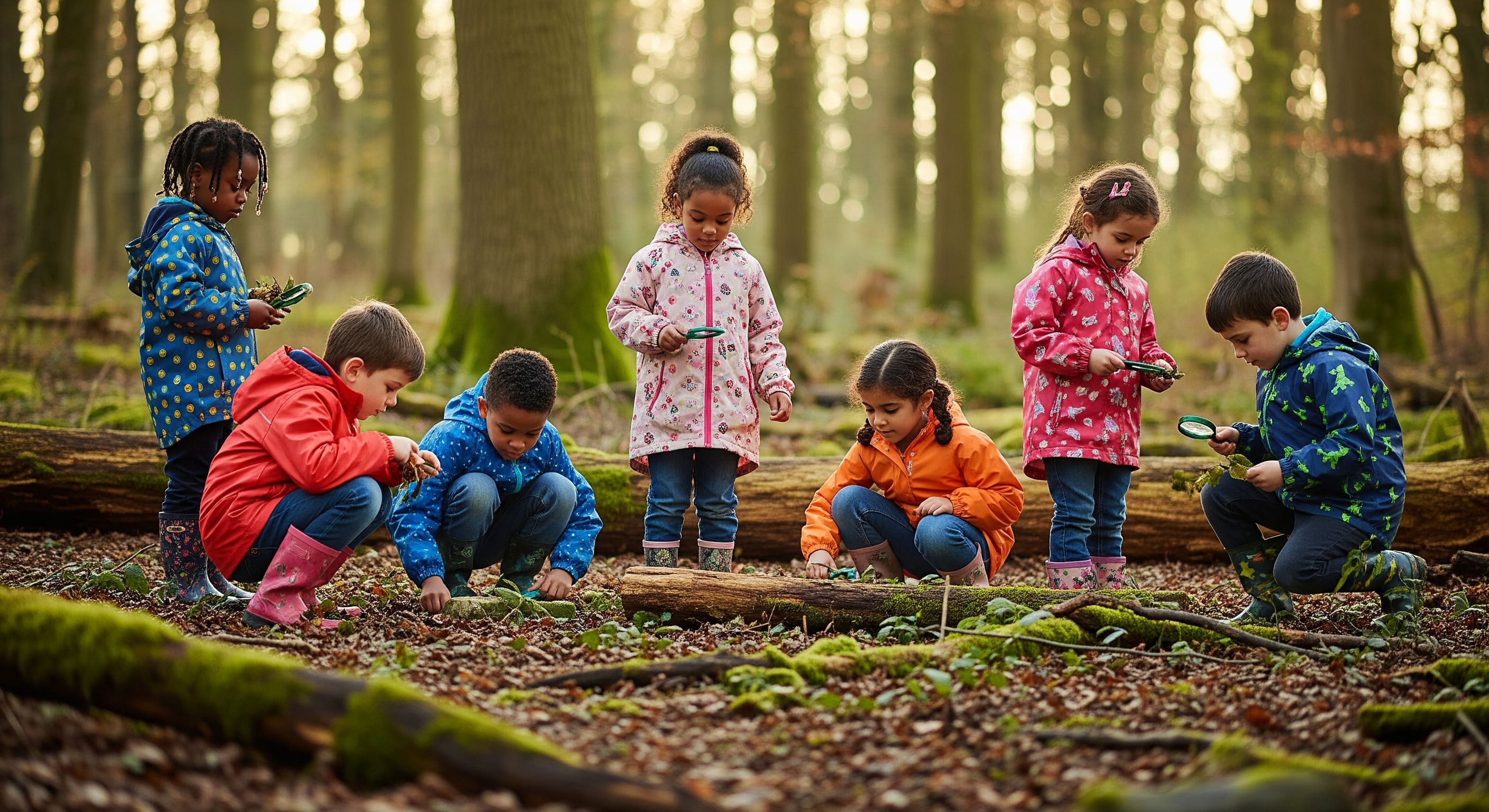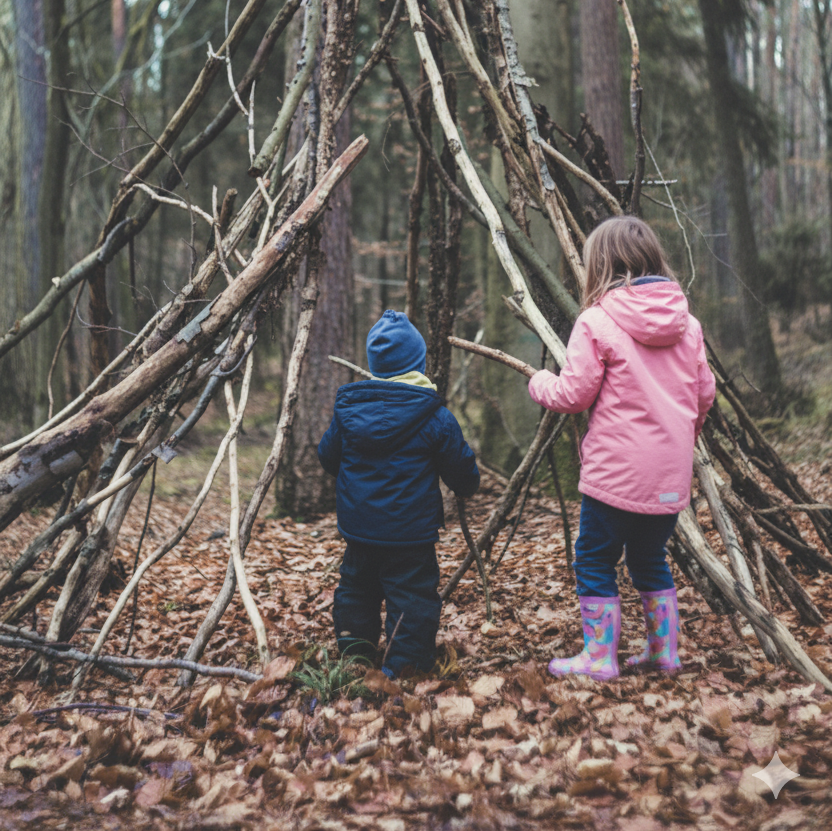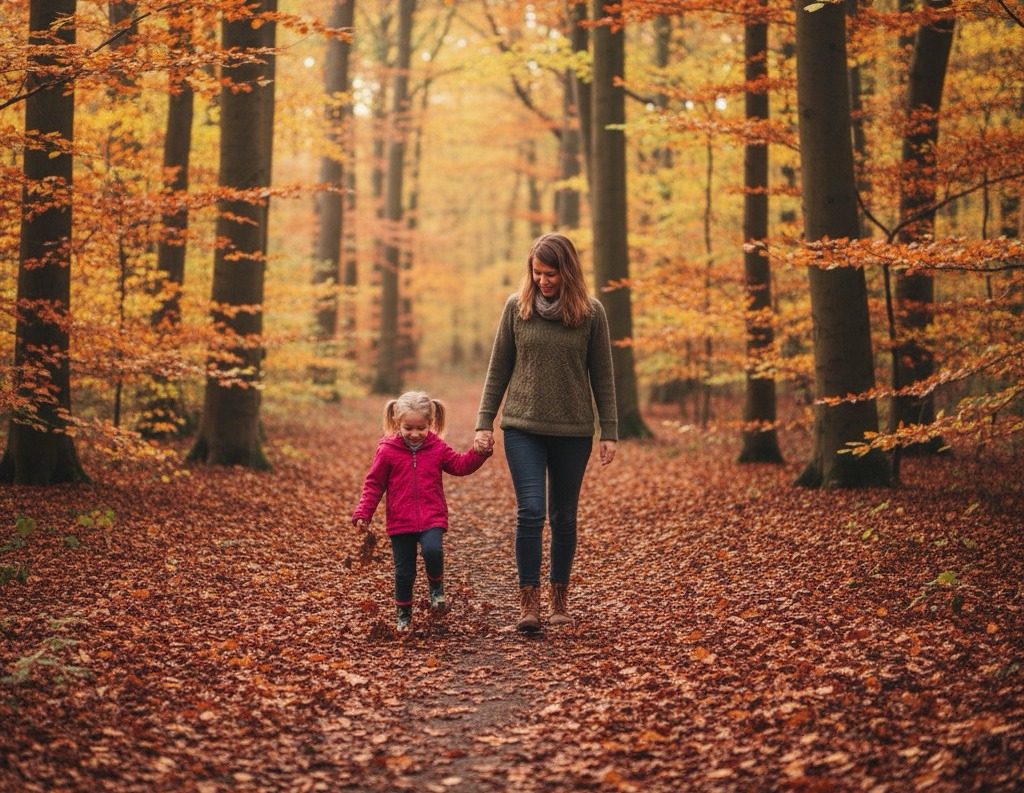· guides · 10 min read
Choosing a Forest School: Key Questions for Parents
Your comprehensive guide to finding the perfect Forest School for your child! Discover essential questions to ask, red flags to watch for, and insider tips to ensure you make the best choice for your family.

Finding the right Forest School for your child can feel overwhelming. With the growing popularity of outdoor education in the UK, more providers are emerging – but not all Forest Schools are created equal. The right choice can spark a lifelong love of nature and learning, while the wrong one might leave your child feeling disconnected or unsafe.
Quick Navigation:
- Understanding Forest School Standards
- Essential Questions to Ask
- Safety and Qualifications
- Philosophy and Approach
- Practical Considerations
- Red Flags to Watch For
The Forest School approach, rooted in Scandinavian outdoor education principles, offers children the chance to develop confidence, independence, and a deep connection with nature through regular, long-term outdoor experiences. But to truly benefit from this approach, you need to find a provider that embodies these values authentically.
Looking for Forest Schools in your area? Check out our Forest School directory to find qualified providers near you.
Want to personalise your questions?
Our Interview Kit Tool helps you create a customised list of questions based on your specific priorities and concerns. Get a personalised set of questions to ask potential Forest School providers.
Understanding Forest School Standards
What Makes a ‘True’ Forest School?
Before diving into specific questions, it’s crucial to understand what distinguishes a genuine Forest School from outdoor play groups or nature activities. The Forest School Association defines Forest School as:
A child-centred inspirational learning process that offers opportunities for holistic growth through regular sessions in a natural environment.
| Core Forest School Principles | What This Means in Practice |
|---|---|
| Child-led learning | Activities emerge from children’s interests, not rigid lesson plans |
| Long-term process | Regular sessions over months/years, not one-off events |
| Holistic development | Focus on emotional, social, physical, and intellectual growth |
| Natural environment | Predominantly outdoors in woodland or natural settings |
| Risk-benefit approach | Calculated risks that support learning and development |
| Qualified leadership | Leaders trained in Forest School pedagogy |
Qualification Levels to Look For
Not all Forest School training is equivalent. Here’s what to look for:
Level 3 Forest School Leader (Minimum Standard):
- Can lead Forest School sessions independently
- 2-year training programme
- Includes child development, risk assessment, and practical skills
Level 4 Forest School Practitioner:
- Advanced training for experienced leaders
- Can mentor other practitioners
- Deeper understanding of Forest School pedagogy
Additional Relevant Qualifications:
- First Aid (Paediatric and Outdoor)
- DBS (Disclosure and Barring Service) checks
- Relevant teaching or childcare qualifications
Essential Questions to Ask
About the Leader and Team
Start with these fundamental questions:
“What Forest School qualifications do your leaders hold?”
- Look for Level 3 minimum, ideally from FSA-recognised training providers
- Ask to see certificates if you’re unsure
“How long have you been running Forest School sessions?”
- Experience matters – newer providers may still be finding their feet
- Established providers can share success stories and learning journeys
“What’s your adult-to-child ratio?”
- FSA recommends maximum 1:8 for mixed ages, 1:6 for under-5s
- Smaller ratios often indicate better quality provision
“Do you have current first aid training and DBS checks?”
- Essential for any childcare provision
- Ask about outdoor/wilderness first aid specifically
About Their Approach and Philosophy
Understanding their educational philosophy is crucial:
“How do you follow children’s interests in your sessions?”
- Listen for examples of child-led activities
- Good providers will share specific stories of how children’s curiosity shaped sessions
“Can you describe a typical session structure?”
- While child-led, there should be some framework (opening circle, free exploration, closing reflection)
- Be wary of rigid timetables or adult-directed activities
“How do you handle risk and safety?”
- Look for “risk-benefit approach” language
- They should explain how they assess and manage risks while allowing appropriate challenges
Example Response to Look For: “We start each session with a circle where children share what they’d like to explore. Last week, one child found a fallen branch and this led to a whole group creating a den. We assess risks like sharp edges or unstable structures, but we let children test their own limits in climbing and balancing.”
About the Environment and Resources
“Can you show me around the Forest School site?”
- The space should feel wild and natural, not overly manicured
- Look for varied terrain, natural materials, and established trees
“What tools and equipment do children use?”
- Real tools (knives, saws, fire-making equipment) are part of authentic Forest School
- Ask about age-appropriate progression and safety protocols
“How do you manage sessions in all weather?”
- “There’s no such thing as bad weather, only inappropriate clothing”
- They should have weather contingency plans and appropriate shelter
| Site Features to Look For | Why They Matter |
|---|---|
| Varied terrain | Different elevations, textures, and challenges |
| Natural materials | Logs, stones, leaves for creative play |
| Established trees | Climbing opportunities and shelter |
| Water features | Streams or ponds for exploration (with safety measures) |
| Fire circle | Central to Forest School philosophy and learning |
| Basic shelter | For extreme weather or storage |
Safety and Qualifications
Insurance and Legal Requirements
Don’t assume – always ask:
“What insurance do you carry?”
- Public liability insurance is essential (minimum £2 million)
- Professional indemnity insurance for educational activities
- Ask to see current certificates
“Are you registered with Ofsted (if applicable)?”
- Required for regular childcare provision
- Registration shows they meet national standards
“What are your safeguarding policies?”
- Should have clear child protection procedures
- Leaders should understand reporting procedures
Emergency Procedures
“What’s your emergency action plan?”
- Should include evacuation routes, emergency contacts, and nearest hospital
- Ask about communication methods if mobile reception is poor
“How do you handle medical emergencies or injuries?”
- Look for outdoor first aid training
- Should have clear procedures for different severity levels
Philosophy and Approach
Child Development Understanding
A quality Forest School provider should demonstrate deep understanding of child development:
“How do you support children who are anxious about outdoor activities?”
- Look for patience, understanding, and gradual introduction strategies
- No child should be forced to participate
“How do you adapt activities for different ages and abilities?”
- Should have strategies for mixed-age groups
- Understanding of individual needs and learning styles
“What learning outcomes do you focus on?”
- Should mention confidence, independence, social skills, creativity
- Avoid providers who focus solely on academic outcomes
Long-term Commitment
“How long do children typically attend your sessions?”
- Forest School benefits develop over time – ideally 6+ months
- Ask about progression and development tracking
“How do you document and share children’s progress?”
- Many providers use photo journals or learning stories
- Parents should receive regular updates on their child’s development
Practical Considerations
Logistics and Communication
“What are your session times and frequency?”
- Regular sessions (weekly is ideal) are more beneficial than sporadic ones
- Consider how this fits with your family schedule
“What’s your weather cancellation policy?”
- True Forest Schools rarely cancel for weather
- Understand their extreme weather procedures
“What should my child bring to sessions?”
- Should provide detailed clothing and equipment lists
- May provide some items (tools, waterproofs) or require parents to supply
“How do you communicate with parents?”
- Regular updates, photos, newsletters
- Clear communication channels for concerns or questions
For detailed guidance on Forest School clothing, check out our comprehensive dressing guide.
Costs and Value
“What’s included in your session fees?”
- Some providers include snacks, tools, or waterproofs
- Understand any additional costs (trips, special equipment)
“Do you offer trial sessions or taster days?”
- Many quality providers offer this to ensure good fit
- Opportunity to observe their approach firsthand
| Cost Factors to Consider | Typical Price Range (UK) |
|---|---|
| Weekly sessions (2-3 hours) | £15-£35 per session |
| Holiday camps (full day) | £25-£50 per day |
| Equipment provision | May add £5-£15 per session |
| Registration fees | £10-£50 one-time fee |
Prices vary significantly by region and provider quality
Red Flags to Watch For
Warning Signs of Poor Practice
Be cautious if you encounter any of these red flags:
❌ Unqualified Leaders
- No Forest School training or unclear about qualifications
- Reluctance to show certificates or training records
❌ Safety Concerns
- No risk assessments or dismissive attitude toward safety
- Inappropriate adult-to-child ratios
- Lack of first aid training or emergency procedures
❌ Rigid, Adult-Led Approach
- Highly structured activities with little child input
- Focus on academic learning rather than holistic development
- Inability to adapt to children’s interests
❌ Poor Communication
- Vague responses to your questions
- No clear policies or procedures
- Reluctance to let you observe sessions
❌ Unsuitable Environment
- Heavily managed or artificial outdoor spaces
- Lack of natural materials and varied terrain
- No weather protection or inappropriate site safety
Questions That Should Raise Concerns
If a provider can’t answer these questions clearly, consider looking elsewhere:
- “We don’t really follow the Forest School Association guidelines”
- “We focus mainly on educational outcomes and school readiness”
- “Children aren’t allowed to use real tools”
- “We usually stay indoors if it’s raining”
- “Our leaders have lots of experience but no formal Forest School training”
Making Your Decision
Observing a Session
If possible, arrange to observe a session in action. Look for:
✅ Child Engagement
- Children appear absorbed, curious, and self-directed
- Natural conversation and collaboration between children
- Comfortable, relaxed atmosphere
✅ Leader Approach
- Patient, responsive leadership style
- Stepping back to let children lead
- Asking open-ended questions rather than giving instructions
✅ Safety Balance
- Appropriate supervision without being overprotective
- Children taking calculated risks and learning from them
- Clear boundaries that make sense to children
Creating Your Shortlist
Use this checklist to compare providers:
| Criteria | Provider A | Provider B | Provider C |
|---|---|---|---|
| Qualified Level 3+ Leader | ✓/✗ | ✓/✗ | ✓/✗ |
| Child-led approach | ✓/✗ | ✓/✗ | ✓/✗ |
| Appropriate site | ✓/✗ | ✓/✗ | ✓/✗ |
| Good adult:child ratio | ✓/✗ | ✓/✗ | ✓/✗ |
| Clear safety procedures | ✓/✗ | ✓/✗ | ✓/✗ |
| Regular sessions available | ✓/✗ | ✓/✗ | ✓/✗ |
| Good communication | ✓/✗ | ✓/✗ | ✓/✗ |
| Fits budget | ✓/✗ | ✓/✗ | ✓/✗ |
Trust Your Instincts
Beyond the practical checklist, consider:
- Do you feel comfortable with the leader? Your child will be spending significant time with them
- Does your child seem excited about attending? Their enthusiasm is a good indicator
- Does the provider’s philosophy align with your values? Consistency between home and Forest School helps children thrive
What to Expect in the First Few Sessions
Settling-In Period
Don’t expect immediate transformation. Quality Forest School providers understand that:
- Some children need time to adjust to outdoor environments
- Confidence and independence develop gradually
- Each child’s journey is unique and should be respected
Typical progression might include:
- Week 1-2: Exploration and boundary setting
- Week 3-4: Building relationships and comfort with space
- Week 5-8: Increased independence and skill development
- Week 9+: Child-led projects and deeper learning
Supporting Your Child’s Journey
You can help by:
- Maintaining consistent attendance for routine
- Discussing their experiences without over-questioning
- Providing appropriate outdoor clothing
- Trusting the process and your provider’s expertise
Conclusion: Finding Your Perfect Match
Choosing the right Forest School is an investment in your child’s long-term development. The questions and considerations outlined in this guide will help you identify providers who truly understand and embody the Forest School philosophy.
Remember, the best Forest School for your child is one where they feel safe, valued, and free to explore their natural curiosity. Take time to visit multiple providers, ask detailed questions, and trust your instincts about where your child will thrive.
The journey of finding the right Forest School provider is worth the effort. When you find the right match, you’ll witness your child developing confidence, creativity, and a deep connection with the natural world that will benefit them throughout their lives.
Ready to start your search? Browse qualified Forest School providers in your area using our Forest School Finder directory. For more insights into Forest School benefits, read our beginner’s guide to Forest School advantages.
Frequently Asked Questions
Q: How do I know if my child is ready for Forest School?
A: Most children from 18 months onwards can benefit from Forest School, though readiness varies individually. Look for basic mobility, some ability to follow simple instructions, and comfort being away from parents for short periods. Many providers offer taster sessions to help assess readiness.
Q: What if my child has special educational needs or disabilities?
A: Quality Forest School providers should be experienced in supporting children with diverse needs. The outdoor environment often benefits children with ADHD, autism, or anxiety. Discuss your child’s specific needs during your initial conversation and ask about their experience with similar children.
Q: How do I handle my child’s reluctance to try Forest School?
A: Some children need time to warm up to new experiences. Start with short visits to the site, read books about nature and outdoor adventures, and maintain a positive, pressure-free attitude. Never force participation – the right provider will work with reluctant children patiently.
Q: Should I be concerned about my child getting dirty or injured?
A: Getting muddy is part of the Forest School experience! Quality providers balance appropriate risk-taking with safety. Minor scrapes and getting dirty are normal – focus on whether your child is happy, engaged, and developing confidence rather than staying pristine.
Q: What’s the difference between Forest School and outdoor nursery/playgroup?
A: Forest School is characterised by regular, long-term sessions led by specially trained practitioners, child-led learning, and a specific pedagogical approach. Outdoor nurseries may spend time outside but don’t necessarily follow Forest School principles or have qualified Forest School leaders.



